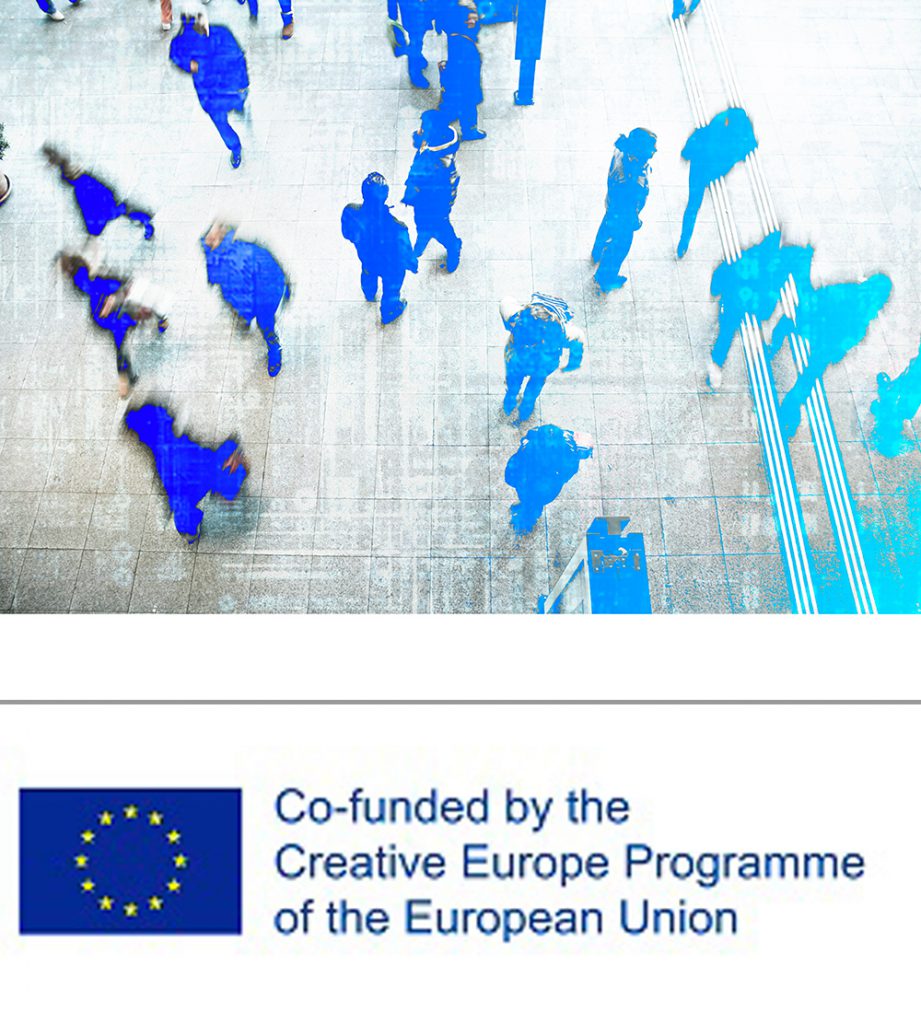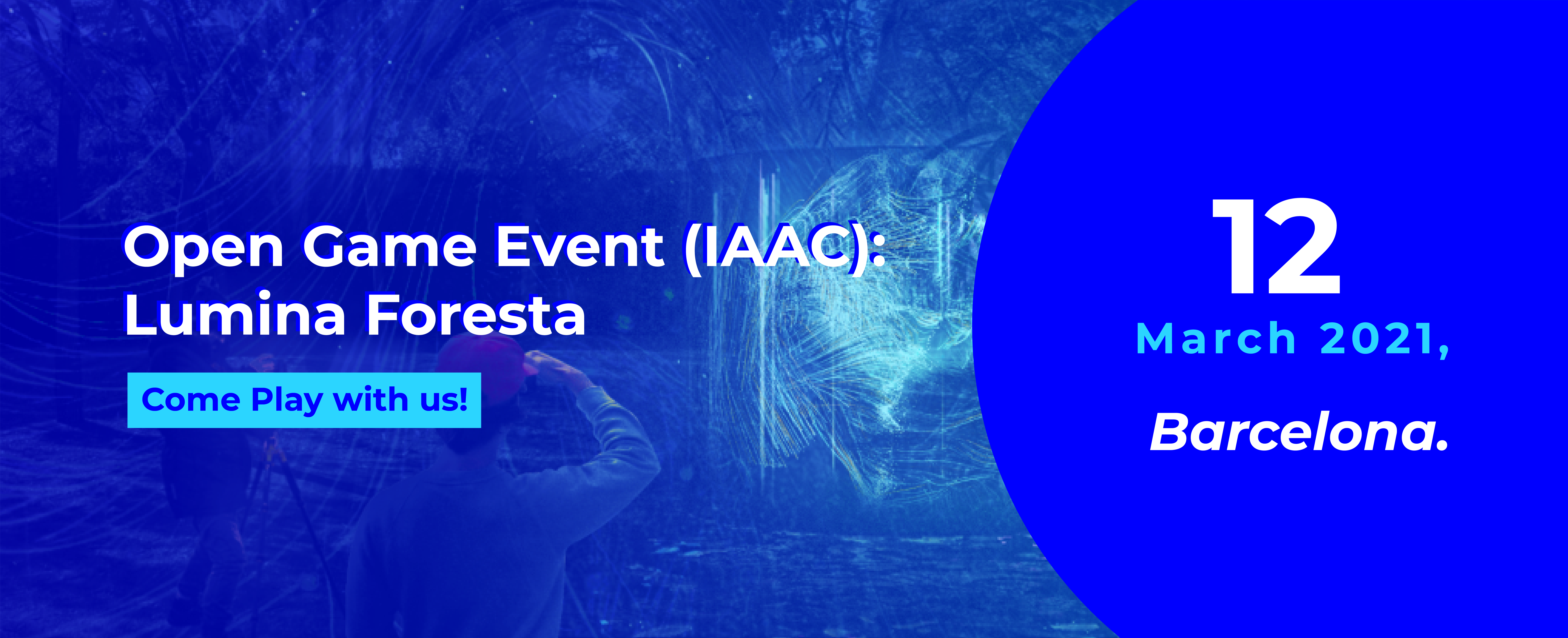
OPEN GAME EVENT IN BARCELONA (IAAC)
RESULTS
Lumina Foresta, the second PPS Open Game Event, was carried out by the Institute for Advanced Architecture of Catalonia (IAAC) in Barcelona on the 12th March 2021. Lumina Foresta is a deployable interactive installation that engages citizens in public spaces in a process of discovery, learning and co-design, focused on the topics of sustainability and re-naturalisation of the urban environment.
First, it raises awareness on the positive impact of trees in compensating human CO2 emissions and, afterwards, it involves citizens in a collective co-design experience, equipping them with plant seeds as tools for urban placemaking.
The importance of re-naturalisation and ecological restoration in cities is today widely acknowledged by policy makers and the scientific community, particularly the presence of trees in urban environments. Trees can transform CO2 particles into Oxygen (O2), and 500 trees are needed to compensate one human being’s CO2 yearly emissions. Trees are nurturing the environment and can help to mitigate the impact of human activities, but many more trees are still needed to be planted to compensate for the emissions of every human being. However, this relevance is not yet diffused in the wider audience of civil society, thus the need of systemic knowledge development and educative engaging processes.
The end goal of the Lumina Foresta Open Game Event (OGE) is therefore to engage local stakeholders (including neighborhood associations, policy makers), architecture design students, and citizens in order to raise awareness on the importance of sustainability and re-naturalisation, stimulating a process of participation in public space co-design and demonstrating the potentials of games in placemaking.
Lumina Foresta was designed based on the preliminary findings and experience gathered during the Co-Creation and Capacity Building Workshop held in Barcelona in September 2020. To have more information on the Co-Creation and Capacity Building Workshop, visit the webpage at this link.
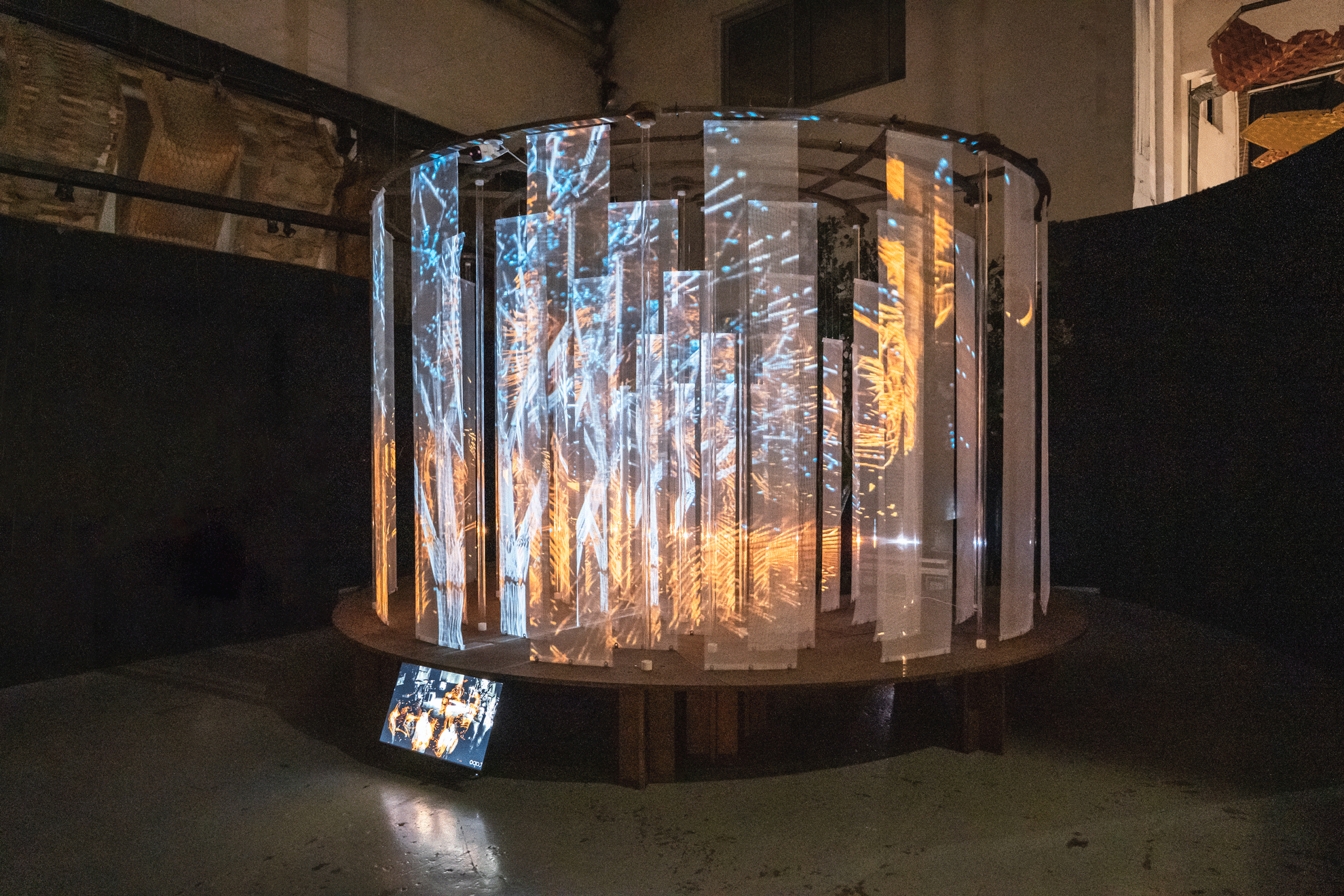
STRUCTURE OF THE GAME
The first part of this interactive installation consisted in the use of gamification strategies and interactive digital technologies to engage citizens in a process of awareness rising on there-naturalization of the public space. Thanks to the use of advanced digital technologies, including video mapping and Computer vision, participants were able to interact with their body movements in front of the installation that projected color patterns to make them aware about their CO2 emissions and the need of trees to compensate them.
In particular, the installation visualizes the CO2 particles part of the footprint of the users, and shows the Oxygen produced by one tree. For each Oxygen Particle produced by the tree 500 CO2 particles are visualized when a person walks near to the installation, making the participants aware about the need of trees to compensate their emissions and to keep the environment in a state of balance. The sophisticated technology of Lumina Foresta allows a playful interaction, generating a different experience according to the movement and the number of the users.
The second phase of the Open Game Event represented a call for action to citizens as co-designers of the public space by becoming tree-planters and suggesting possible configurations of the public realm.
In this second part of the OGE, participants received tailored-designed “Seed Bombs” that contained different types of plant seeds. They were asked to distribute them on the areas of the public space that they would like to re-naturalise based on the knowledge gathered in the first phase. At the end of the event, they received these “Seed Bombs” as s artifacts for placemaking action to be used in different areas of the city, spreading the impact of the installation on a broader urban dimension.
The ultimate goal of the installation was to raise awareness among participants on the positive impact that nature has in cities. The visualization of the CO2 that each citizen bodies emits empowers them to express more informed decisions on how to transform and re-naturalise the public space.
INTERACTIVE INSTALLATION BACKGROUND
Lumina Foresta is an interactive installation developed with computational design technologies listed below:
- Construction:
Lumina Foresta 10sqm installation was built by architectural students that used specific 3D design tools, mainly Rhino with Grasshopper plug-ins. Working in 3D allowed the transfer of their designs and geometries to rapid 1:1 fabrication. Using sustainable materials (mainly wood and semitransparent textiles) the pavilion was built using a big format milling machine, laser cut and 3D printing allocated in the atelier facilities of IaaC.
- Interaction:
Once built, Lumina Foresta was ready to receive new technologies to foster the interaction with users. Those technologies included a night vision camera to track the movement of the visitors, computers, wifi network and video projector. Data of the user-s was analyzed by a Python script that extracted the location and number of people interacting with the installation. This information was transferred live to Touch Design, an interactive video mapping software, that converted the user’s body into an array of CO2 particles. The CO2 data was video projected using a high-definition projector into the multi-layered surface of the installation. The final outcome is an hologram effect that shows the CO2 particles that humans produce in counter balance with the oxygen ones that trees and nature can deploy. The result is an excess of CO2 in negotiation with extinguishing O2.
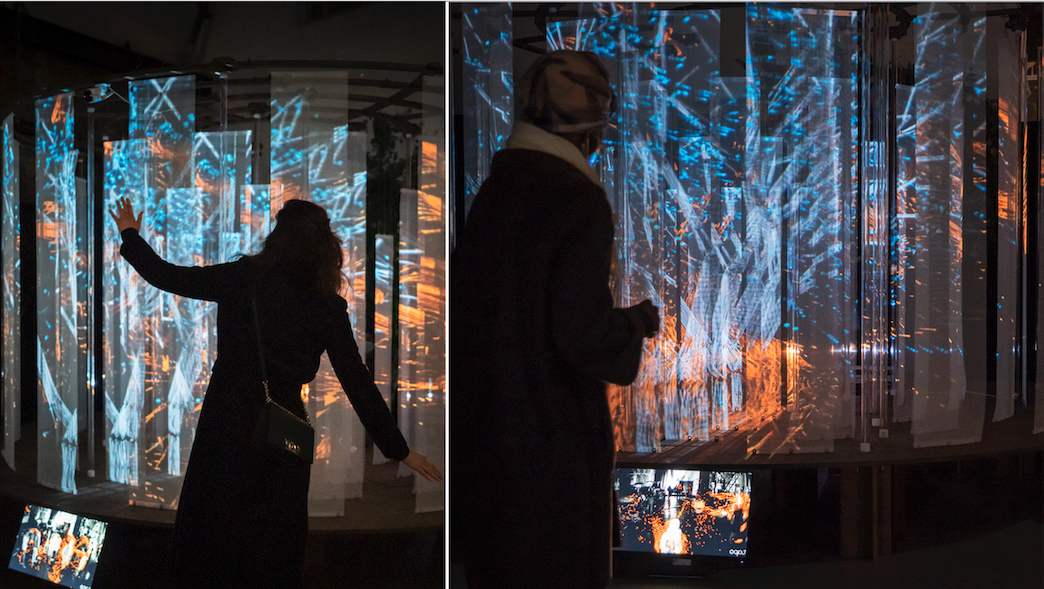
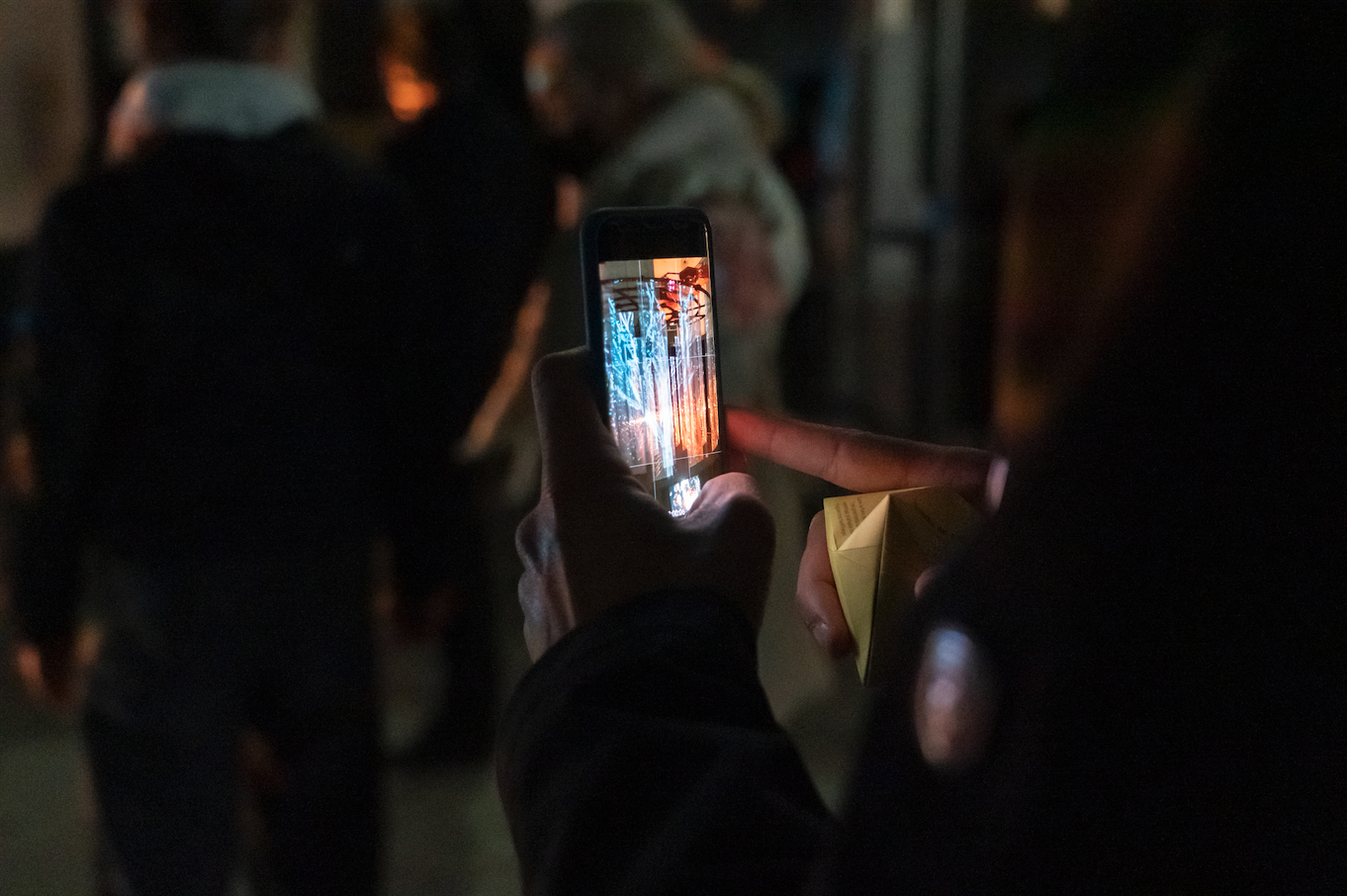
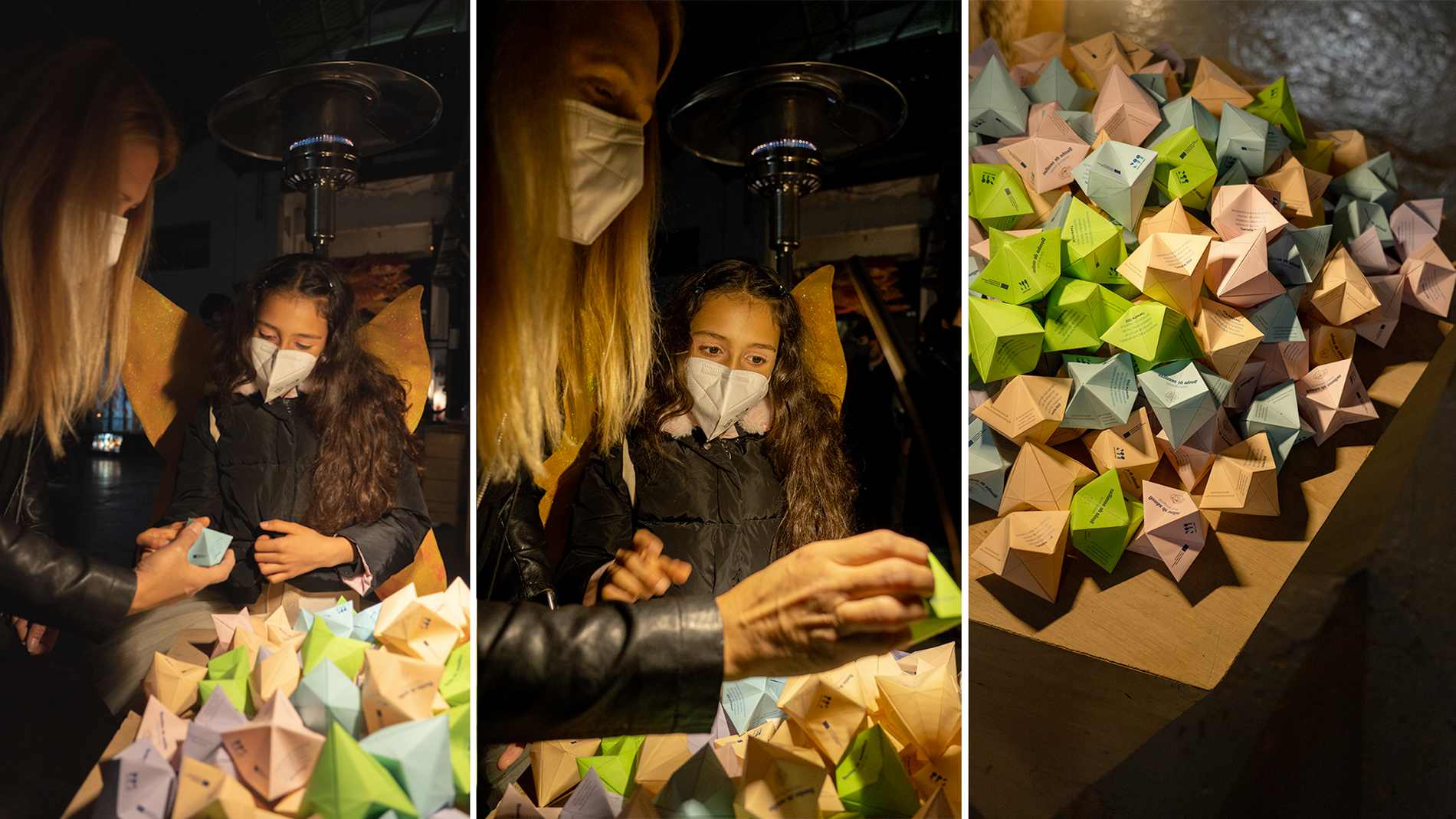
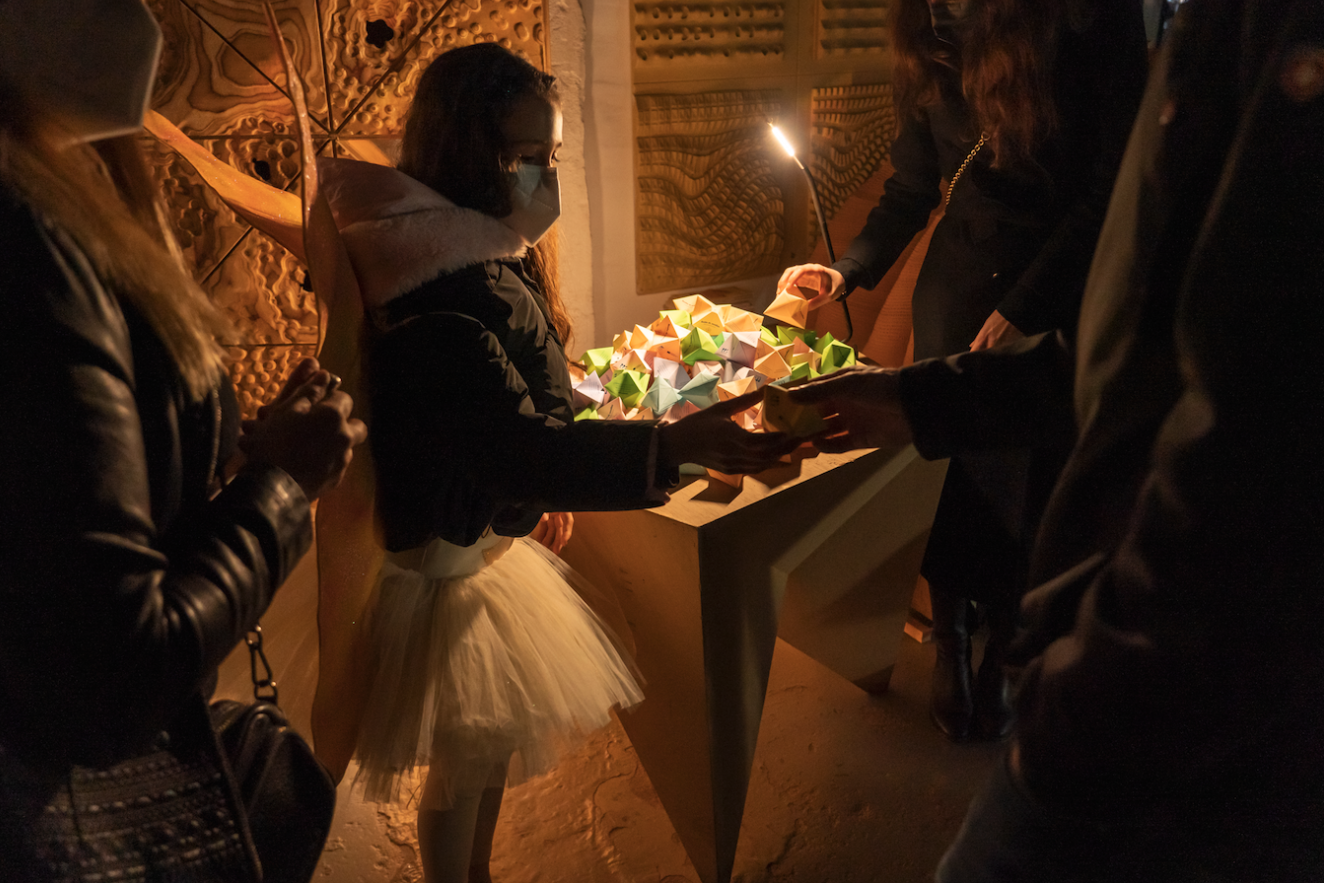
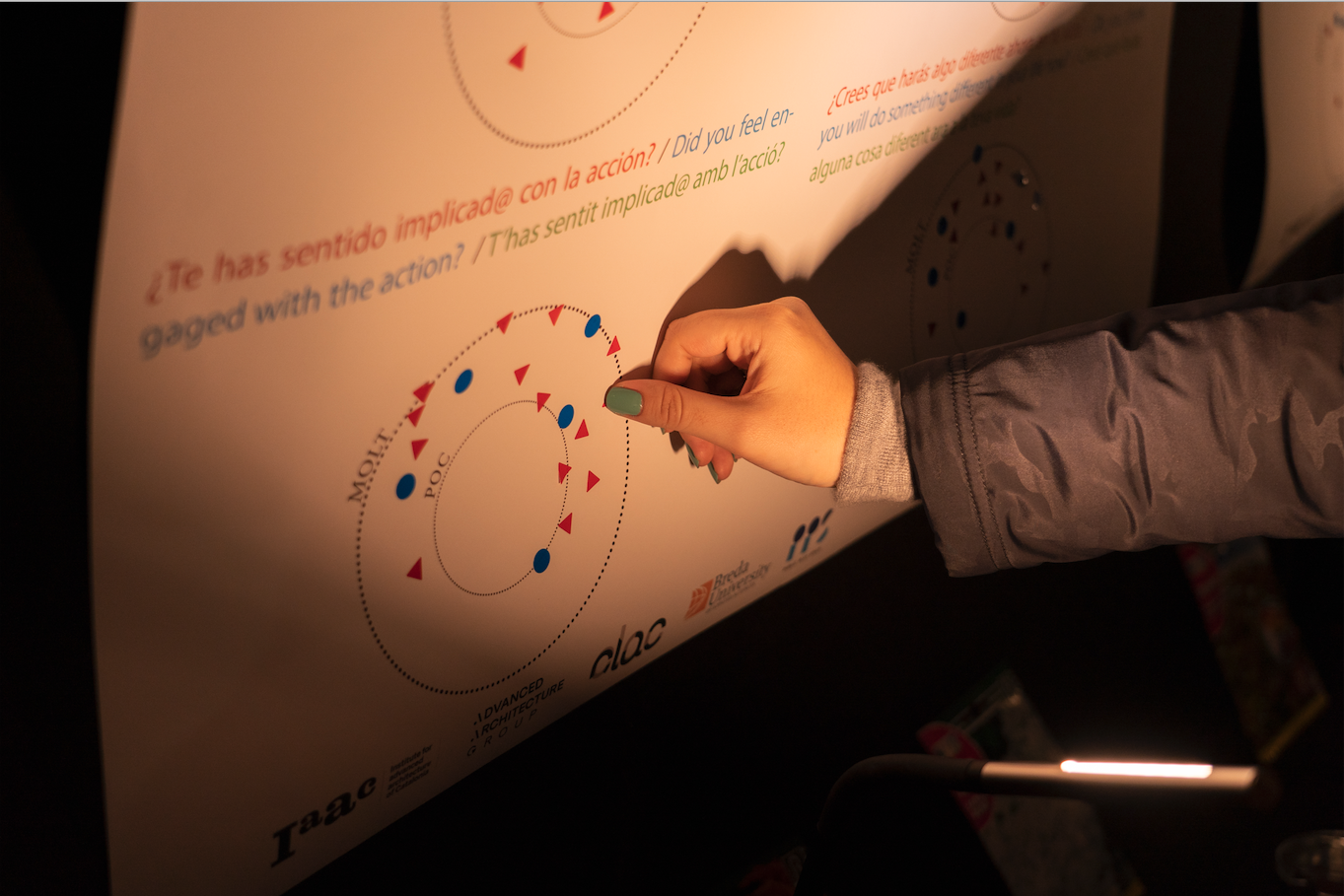
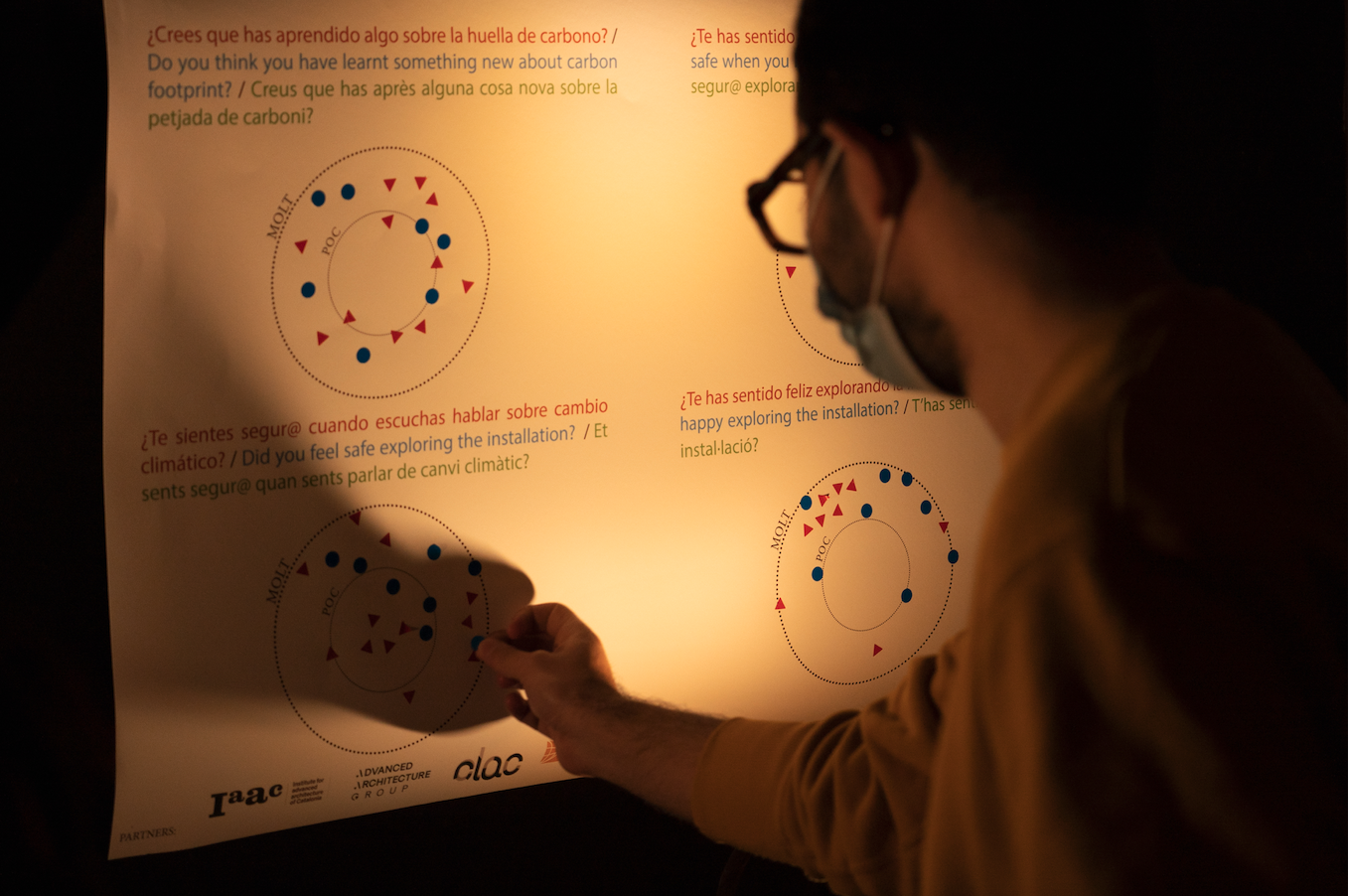
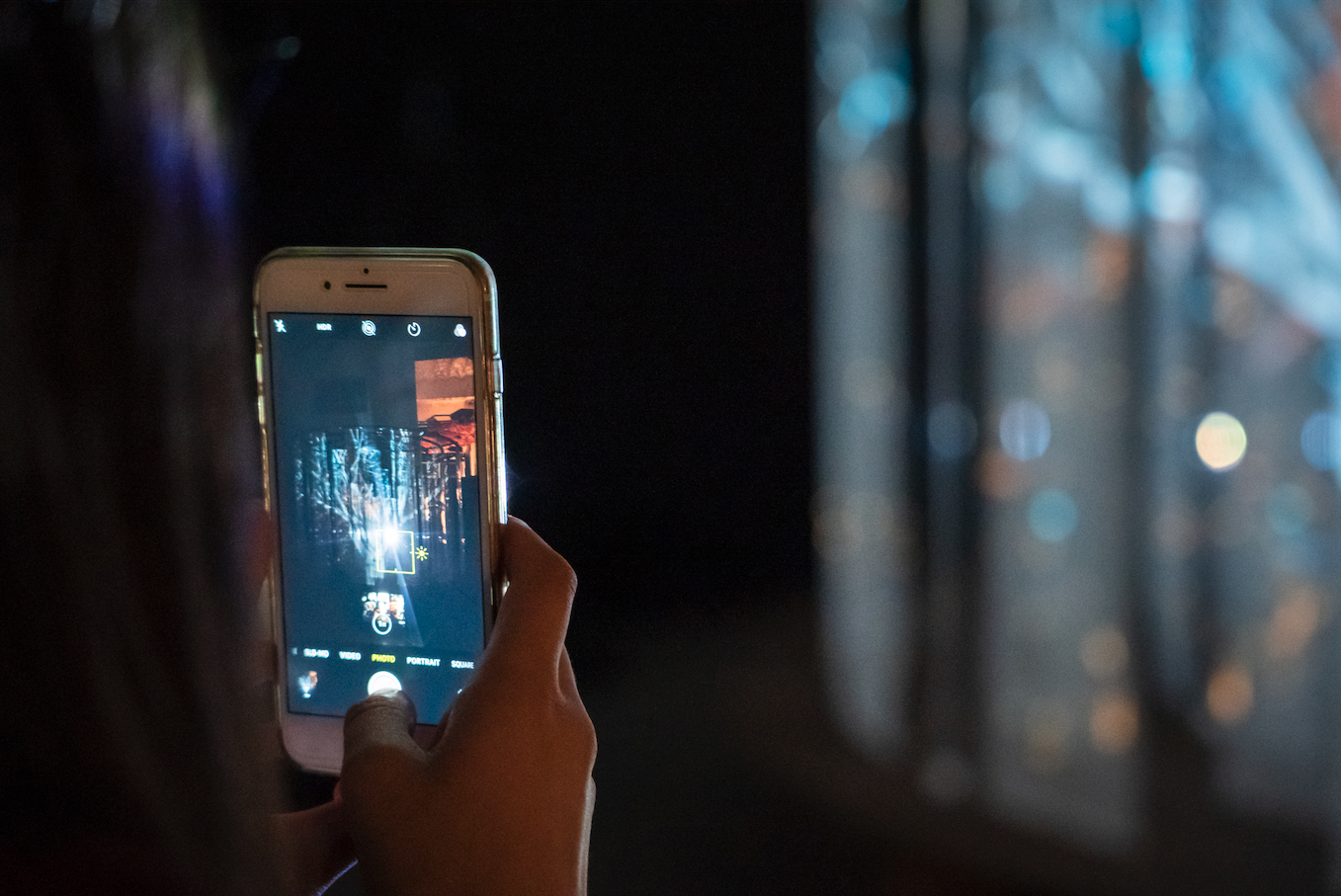
CALL
IAAC is happy to launch the second Open Game Event (OGE) of Public Play Space. The main objective of the OGEs is to engage local stakeholders (including neighbourhood associations, policy makers), architecture and design students, and citizens in order to raise awareness on the importance of participation in cities’ design and on the potentials of games in placemaking.
The Open Game Event of Barcelona, called Lumina Foresta, will take place on the 12 of March 2021 19:00 h in the Headquarters of IAAC – Institute for Advanced Architecture of Catalonia, located in the Poblenou District, the area of Barcelona devoted to the creative and research sector.
If you are in Barcelona on Friday 12 March 2021, come and play with us at 19:00! Register HERE!
Lumina Foresta is a playful interactive installation, designed to be deployed in the public space. Thanks to the use of gamification strategies and interactive digital technologies, the project engages citizens in a process of awareness rising, co-design and re-naturalization of the public space.
Lumina Foresta engages citizens in a process of discovery and co-design: at first the project raises awareness on the positive impact of trees in compensating emissions , afterwards it involves citizens in a collective co-design experience, equipping them with plant seeds.
Did you know that 500 trees are needed to compensate one human being yearly emissions? Trees transform CO2 particles in Oxygen (O2) particles. Trees are nurturing the environment, mitigating the impact of human activities, however several trees are needed to compensate the emissions of one human being.
Lumina Foresta uses advanced digital technologies, including video mapping and Computer vision, to make participants aware about their emissions and the need of trees to compensate them.: The installation visualizes the CO2 particles part of the footprint of the users, and shows the Oxygen produced by one tree. For each Oxygen Particle produced by the tree 500 CO2 particles are visualized when a person walks near to the installation, making the participants aware about the need of trees to compensate their emissions and to keep the environment in a state of balance. The sophisticated technology of Lumina Foresta allows a playful interaction, generating a different experience according to the movement and the number of the users.
Raising the awareness of citizens on the positive impact of nature in cities, the visualization of CO2 empowers them to express more informed decisions on how to transform and re-naturalise the public space.
The second phase of the Open Game Event will represent a call to action to citizens as co-designers of the public space. They will become tree-planters, and suggest possible configurations of the public realm. In fact, tailor designed Seed bombs, containing different types of plant seeds, will be given to them; they will be asked to distribute them on the areas of the public space that they would like to re-naturalise, based on the knowledge gathered in the first phase. Moreover, they will be allowed to bring the Seed bombs with them, spreading them around the city.
Lumina Foresta was designed based on the experience gathered and projects developed in the Co-Creation and Capacity Building Workshop held in Barcelona in September 2020.
To have more information on the Co-Creation and Capacity Building Workshop, visit the webpage at this link.
PARTNERS
Ajuntament de Barcelona, Taula Eix Pere IV, CO-MIDA Project
AUDIENCE
The game will involve different groups of 10 participants each. The audience includes citizens of different ages, including children and elderly people
ACTIVITY INFORMATION
The events aims at engaging stakeholders (neighbourhood associations, policy makers), architecture and design students, and citizens (including people that attend participation meetings as well as people that are not common participants in these kind of activities, such as infants, and migrants) driving their attention on the importance of participation in cities design and on the potentials of digital technologies in this context.
In this way, the interest in game and advanced technologies for placemaking will rise amongst new audiences, as well as engaging such audiences in the process of co-design and placemaking of the public space they inhabit.
Each event will take place along 1 day. Stakeholders will be engaged in co-designing one neighbourhood in a target city. This activity will allow cultural operators and public institutions representatives to experiment the use of novel methods of co-design and placemaking with a wide public as well as to collect data about the citizens needs and desires. It will also engage citizens in co-creation processes by strengthening their confidence with participatory processes, education on inclusiveness (learning about other citizens’ needs and desires) and on sustainability (co-designing more efficient and resilient public spaces).
